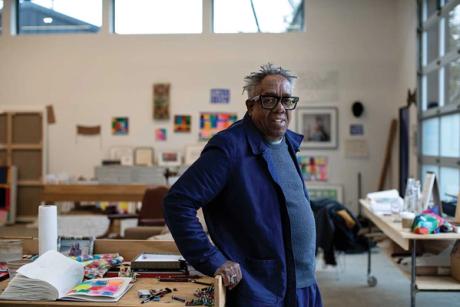[ad_1]

In February, the Buffalo AKG museum opened the first retrospective dedicated to Stanley Whitney. When I read this, I was astonished. But sure enough, it is indeed the 77-year-old’s first museum survey. Also gobsmacking: his 2015 Studio Museum in Harlem exhibition, focusing on then recent work, was his first in a public institution. By then, Whitney was more than a decade into making the square-format canvases with jostling rectangles between bands and strips, all in high colour, that have made him a hugely beloved painter.Those canvases, often seemingly effortless, were the result of nearly 40 years of work. But in the 1970s and 1980s in particular, the art world favoured almost anything but abstract painting—Minimalism, Conceptualism, photography, performance, film and video, figurative painting… Of course, it was even harder if you were a Black artist. As a result, Whitney observed in 2018, “I got to paint from the 1970s to the 1990s almost undisturbed.”When I ask him about this on the A brush with… podcast he admits it was “downright awful”. But he conjures a vivid picture of those fallow years. “At the time, I was living downtown… in what’s now Tribeca, and I had my studio up on Cooper Square, and I’d walk through SoHo, through the galleries, and I’d get to my studio, and I would say: ‘Okay, you see what they’re like, you see what they’re doing, you see what’s fashionable. You could do that. Or do you want to keep doing this?’ And I would say: ‘I want to keep doing this.’ That was my choice.” Crucially, he had moral guides: he mentions the late-1940s paintings that Willem de Kooning, then in his 40s, had “worked and worked on” in relative obscurity.Would Whitney have arrived where he is now if he had had more curatorial and critical attention? One thing he did have was lots of correspondence with artists, from Philip Guston to David Hammons, from his wife, the painter Marina Adams, and the many students he taught over decades. In this, Whitney shares an experience with other artists who had to wait for long-deserved acclaim, like the late Phyllida Barlow.Whitney and Barlow’s language was fully formed when they achieved fame; both were able to greet success as the imposter it is. How many younger artists’ work has suffered through being thrust into the spotlight at a less mature moment in their development? The explosion of attention given to the 1990s generation of British artists, as well as prompting much great work, interrupted promising lines of enquiry, and propelled some artists into mannered cul-de-sacs and over-production. Some were able to spot it: Rachel Whiteread recognised she was in danger of becoming a producer rather than a maker and pulled back from the brink, to her credit and to her work’s benefit. Others of her generation would not sustain a major museum retrospective. Young artists caught up in the market’s recent fetish for “ultra-contemporary” figurative painting feel vulnerable to a similar pattern.In Whitney’s case, two things are true: that he waited absurdly long for recognition and that, as he says, “in the long run it really worked out”, as his Buffalo retrospective proves. At least, unlike many other artists now being widely shown after being unjustly ignored, he is alive to enjoy it.• Stanley Whitney: How High the Moon, Buffalo AKG Art Museum, Buffalo, until 27 May; Walker Art Center, Minneapolis, 13 November-16 March 2025; Institute of Contemporary Art Boston, 17 April 2025–1 September 2025
[ad_2]


























